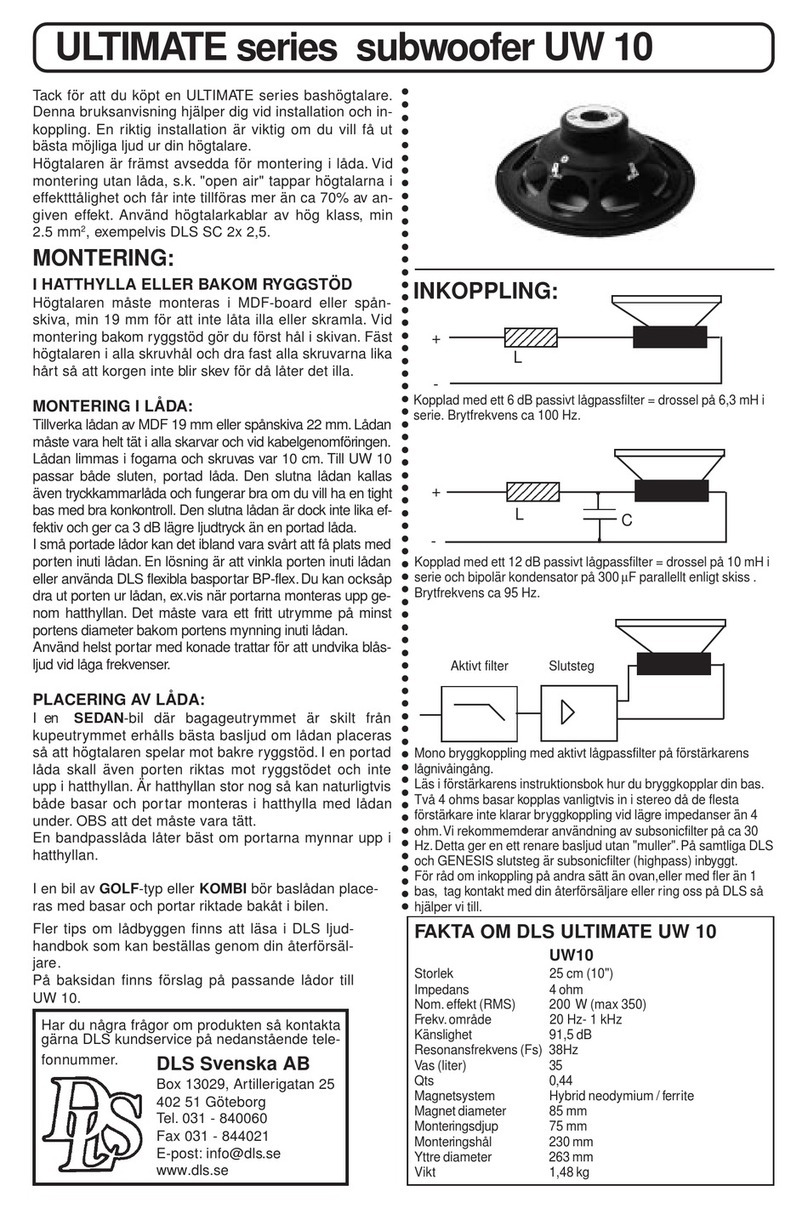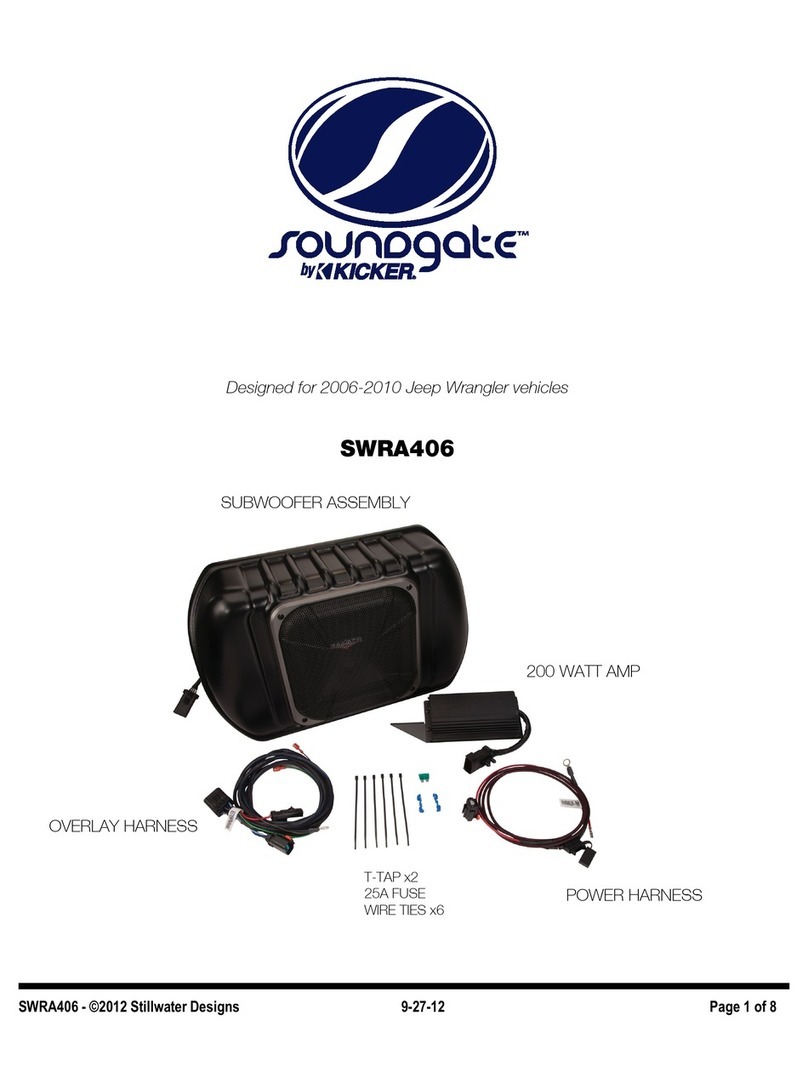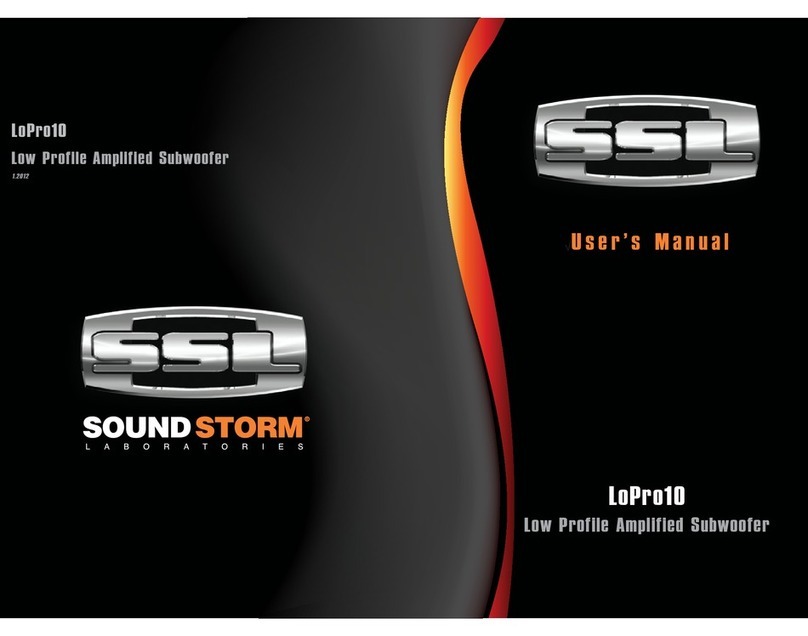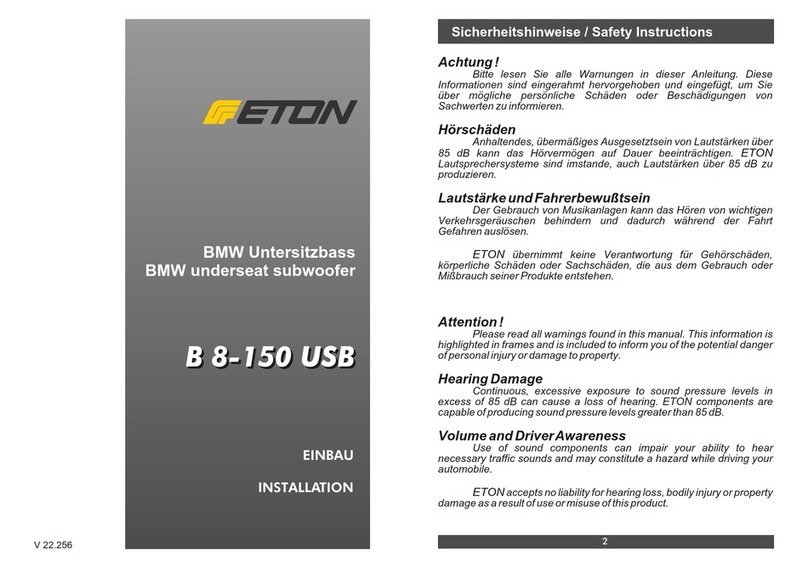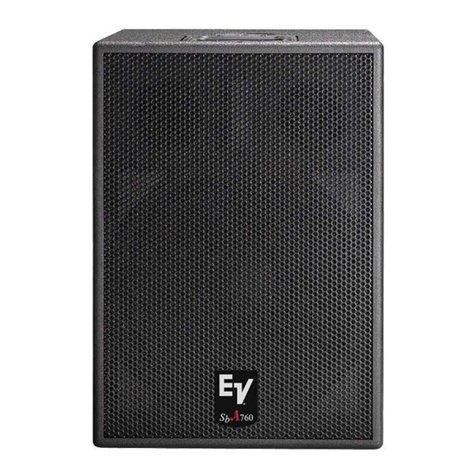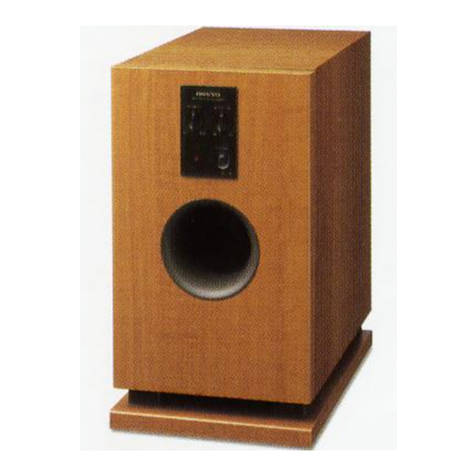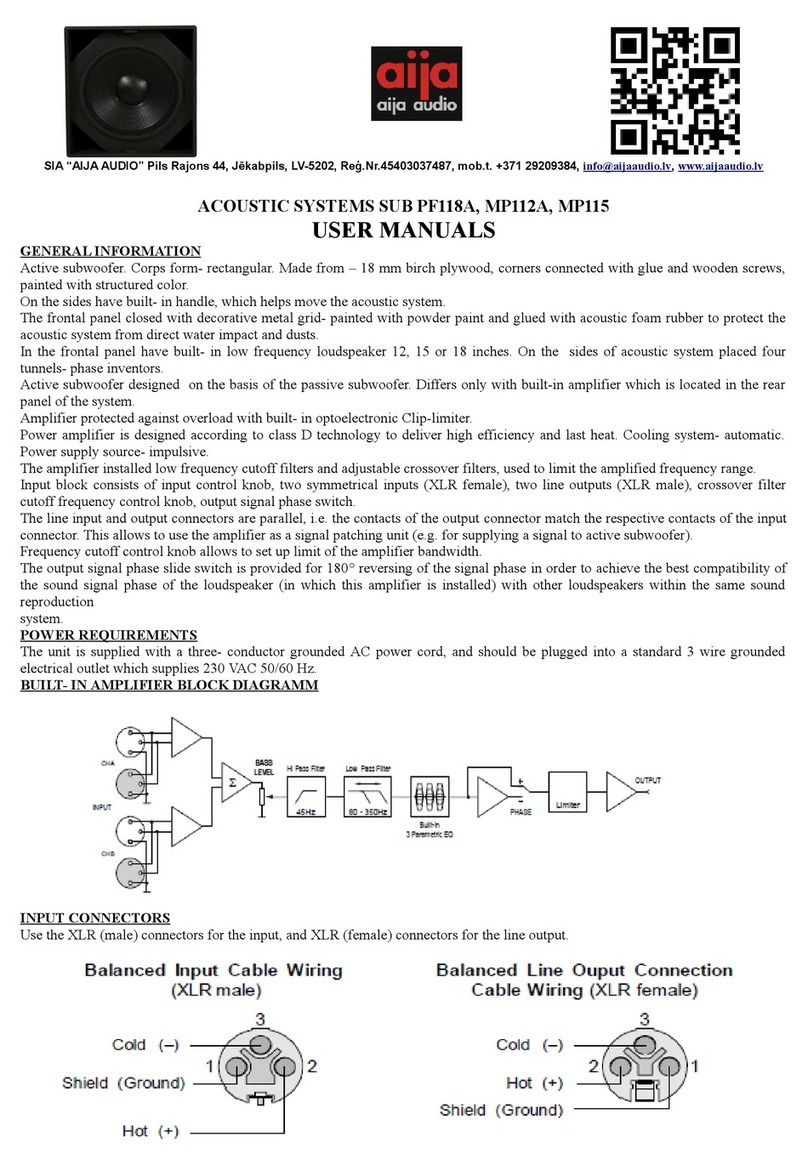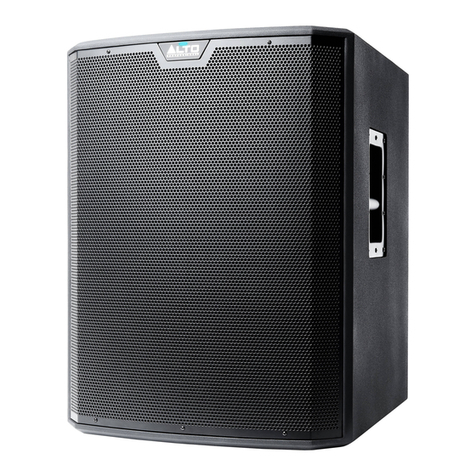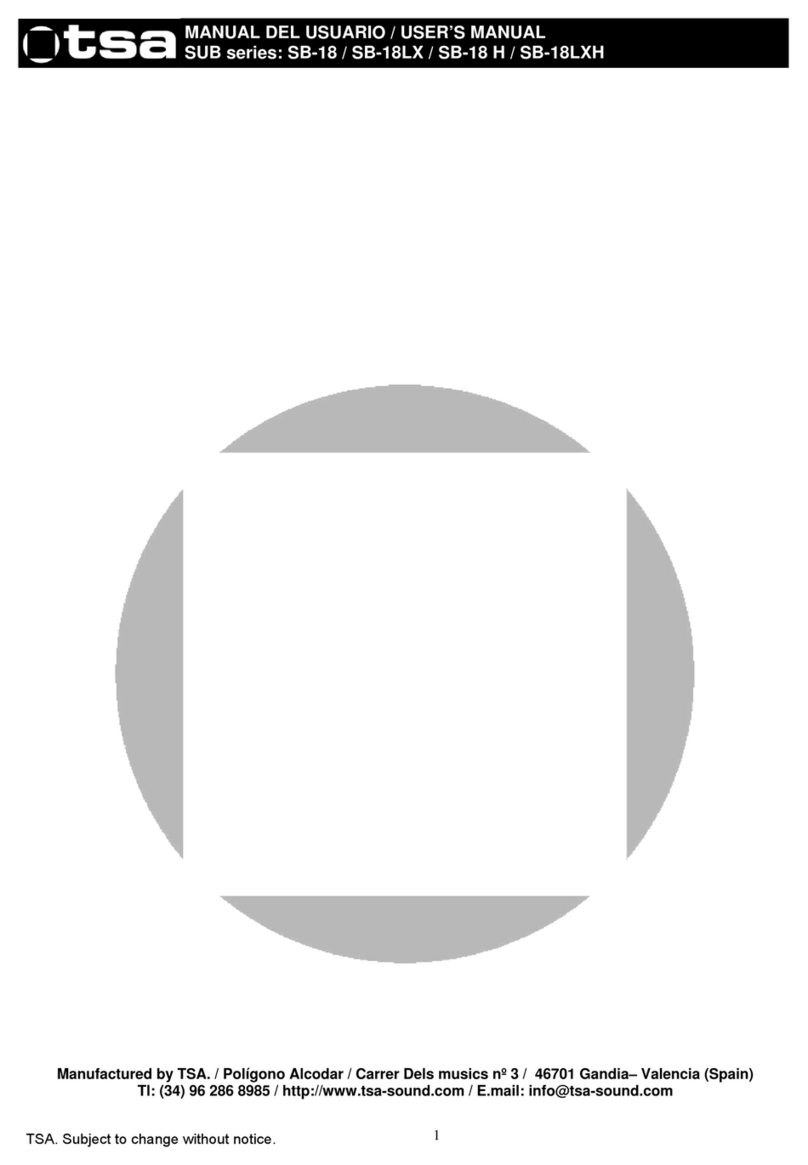PSB SubSeries 6i User manual

SubSeries
6i,
SubSeries
5i,
SubSeries
1,
Powered
Subwoofers
OWNER'S
GUIDE
I.
IMPORTANT
SAFETY
INSTRUCTIONS
II.
INTRODUCTION
III.
QUICKSTART
IV.
FEATURES,
CONTROLS,
AC
POWER
A.
Sub
Volume
Control
(Figure
1)
B.
On
Indicator
Light
(Figure
1)
C.
AC
Power
Connection
D.
Sub
Cut-Off
Frequency
Control
(Figure
1)
E.
High/Speaker
Level
Terminals
(Figure
2)
F.
AC
Power
Socket
(Figure
2)
G.
External
Fuse
(Figure
2)
H.
Low/Line
Level
Jacks
(Figure
2)
I.
Phase
Switch
(Figure
2)
J.
LFE
Input/Crossover
Bypass
Switch
(Figure
2)
K.
Power
Switch
(Figure
2)
L.
Amplifier
Panel
(Figure
2)
V.
ROOM
ACOUSTICS,
SUBWOOFER
PLACEMENT,
MULTIPLE
SUBWOOFERS
&
SETTING
THE
CONTROLS
VI.
CONNECTING
THE
SUBWOOFER
TO
YOUR
AUDIO
SYSTEM
A.
The
SubSeries
1
B.
The
SubSeries
5i
C.
The
SubSeries
6i
D.
Using
Multiple
Subwoofers
VII.
SET-UP
CALIBRATION
VIII.
SPECIFICATIONS
www.psbspeake~.com·
Ph.,,:
(888)
772-00oo.r
(905)
831-8555
IE


I.
IMPORTANT
SAFETY
INSTRUCTIONS
1.
Read
these
instructions.
2.
Keep
these
instructions.
3.
Heed
all
warnings.
4.
Follow
all
instructions.
5.
Do
not
use
this
apparatus
near
water.
6.
Clean
only
with
dry
cloth.
7.
Do
not
block
any
ventilation
openings.
Install
in
accordance
with
the
manufacturer's
instructions.
8.
Do
not
install
near
any
heat
sources
such
as
radiators,
heat
registers,
stoves,
or
other
apparatus
(including
amplifiers)
that
produce
heat.
9.
Do
not
defeat
the
safety
purpose
of
the
polarized
or
grounding-type
plug.
A
polarized
plug
has
two
blades
with
one
wider
than
the
other.
A
grounding
type
plug
has
two
blades
and
a
third
grounding
prong.
The
wide
blade
or
the
third
prong
are
provided
for
your
safety.
If
the
provided
plug
does
not
fit
into
your
outlet,
consult
an
electrician
for
replacement
of
the
obsolete
outlet.
10.
Protect
the
power
cord
from
being
walked
on
or
pinched
particularly
at
plugs,
convenience
recepta-
cles,
and
the
point
where
they
exit
from
the
apparatus.
11.
Only
use
attachments/accessories
specified
by
the
manufacturer.
12.
Use
only
with
the
cart,
stand,
tripod,
bracket,
or
table
specified
by
the
manufacturer,
or
sold
with
the
apparatus.
When
a
cart
is
used
use
caution
when
moving
the
cart/apparatus
combination
to
avoid
injury
from
tip-over.
13.
Unplug
this
apparatus
during
lightning
storms
or
when
unused
for
long
periods
of
time.
14.
Refer
all
servicing
to
qualified
service
personnel.
Servicing
is
required
when
the
apparatus
has
been
damaged
in
any
way,
such
as
power-supply
cord
or
plug
is
damaged,
liquid
has
been
spilled
or
objects
have
fallen
into
the
apparatus,
the
apparatus
has
been
exposed
to
rain
or
moisture,
does
not
operate
normally,
or
has
been
dropped.
15.
WARNING:
To
reduce
the
risk
of
fire
or
electric
shock,
this
apparatus
should
not
be
exposed
to
rain
or
moisture
and
objects
filled
with
liquids,
such
as
vases,
should
not
be
placed
on
this
apparatus.
16.
To
completely
disconnect
this
equipment
from
the
mains,
disconnect
the
power
supply
cord
plug
from
the
receptacle.
17.
The
mains
plug
of
the
power
supply
cord
shall
remain
readily
operable.
The
lightning
flash
with
arrowhead
symbol
within
an
equilateral
triangle,
is
intended
to
alert
the
user
to
the
presence
of
uninsulated
"dangerous
voltage"
within
the
product's
enclosure
that
may
be
of
sufficient
magnitude
to
constitute
a
risk
of
electric
shock
to
persons.
The
exclamation
point
within
an
equilateral
triangle
is
intended
to
alert
the
user
to
the
presence
of
important
operating
and
maintenance
(servicing)
instructions
in
the
litera-
ture
accompanying
the
product.
Notes
on
environmental
protection
At
the
end
of
its
useful
life,
this
product
must
not
be
disposed
of
with
regular
house-
hold
waste
but
must
be
returned
to
a
collection
point
for
the
recycling
of
electrical
and
electronic
equipment.
The
symbol
on
the
product,
user's
manual
and
packaging,
point
this
out.
The
materials
can
be
reused
in
accordance
with
their
markings.
Through
re-use,
recy-
cling
of
raw
materials,
or
other
forms
of
recycling
of
old
products,
you
are
making
an
important
contribution
to
the
protection
of
our
environment.
Your
local
administrative
office
can
advise
you
of
the
responsible
waste
disposal
point.
3

II.
INTRODUCTION
PSB
subwoofers
are
designed
to
provide
the
flattest
possible
frequency
response,
full
bass
extension,
low
distortion
and
high
output.
Frankly,
these
are
characteristics
that
most
manufacturers
would
strive
for.
Our
years
of
experi-
ence
and
our
sophisticated
design
and
measurement
tools
allow
us
to
achieve
ideal
subwoofer
performance.
Beyond
these
characteristics
there
are
a
few
other
parameters
that
we
uniquely
feel
are
very
important
in
the
design
of
a
sub-
woofer.
First
and
foremost
it
is
important
to
us
that
a
PSB
subwoofer
be
musi-
cal.
In
this
era
of
home
theater
this
might
at
first
seem
out
of
step,
but
we
believe
that
a
musical
subwoofer
will
also
sound
the
most
natural
when
playing
movie
soundtracks.
Furthermore,
an
ideal
subwoofer
should
have
the
ability
to
play
musically
even
under
conditions
of
overload
or
stress.
No
subwoofer
is
so
large
with
its
limits
so
great
that
it
can
never
be
overloaded,
especially
with
modern
movie
soundtracks.
For
this
reason
PSB
subwoofers
incorporate
very
intelligently
applied
proprietary
limiting
circuitry
to
prevent
audible
overload.
The
limiting
circuitry
of
all
PSB
subwoofers
is
a
combination
of
peak
limiting
circuits
that
hold
amplifier
signal
swing
to
the
point
just
short
of
the
amplifiers
clipping,
and
compression
circuitry
that
will
come
in
under
conditions
of
long
term
overload
and
reduce
the
amplifiers
gain.
The
trick
is
to
apply
these
circuits
in
such
a
way
that
they
don't
squeeze
the
life
out
of
the
music
or
movie
sound-
track,
to
allow
the
dynamics
to
get
through
while
preventing
gross
distortion.
We
do
this
by
being
mindful
of
the
dynamics
of
music
and
carefully
tailoring
the
time
constants
of
the
circuits
to
that
of
music.
For
example,
it
is
known
that
most
music
is
performed
with
a
beat
of
80
to
140
beats
per
minute.
Our
test
signals
are
configured
to
follow
this
timing
and
allow
maximum
transient
effect
without
distortion
on
sustained
tones.
We
go
to
great
lengths
to
reduce
any
mechanical
noises
our
subwoofers
may
make.
Woofers
are
designed
never
to
bottom
harshly.
Ports
have
large
radius
end
flares
to
reduce
noise
from
turbulence.
Cabinets
and
amplifiers
are
designed
so
that
no
air
leaks
(which
can
contribute
minute
amounts
of
noise)
are
possi-
ble.
All
of
our
designs
are
exhaustively
tested.
A
subwoofers
design
isn't
com-
plete
until
the
sub's
amp
and
woofer
can
survive
a
15
hour
test
of
being
driven
continuously
to
maximum
output.
SubSeries
1
The
SubSeries
1
has
a
few
unique
features
worth
mentioning.
We
have
mounted
Volume
and
Crossover
controls
on
the
front
of
the
cabinet.
Most
subwoofers
are
tucked
away
in
a
dark
corner
and
once
in
place
it
can
be
very
inconvenient
to
access
the
controls.
Placing
volume
and
crossover
knobs
on
the
front
of
the
cabinet
will
allow
you
to
adjust
these
most
important
functions
more
conve-
niently.
Despite
its
modest
price
the
SubSeries
1
contains
a
simplified
version
of
our
two
part
limiting
circuit
and
a
100
watt
class
AB
amplifier.
4

SubSeries
5i
The
SubSeries
5i
has
more
power
and
a
larger
bass
unit
than
the
SubSeries
1.
It
also
has
a
very
different
Class
H
design
for
its
power
amplification.
Class
H
is
a
special
high
efficiency
amplifier
design.
Briefly,
audio
amplifiers
are
inherently
inefficient
because
they
are
designed
to
have
the
capability
of
delivering
great
output
power
yet
spend
most
of
their
life
delivering
fairly
low
power.
Their
out-
put
devices
must
deliver
current
while
withstanding
the
high
power
supply
"rail"
voltages
needed
for
peak
outputs.
With
a
Class
H
design
the
rail
voltages
are
not
constant.
They
swing
high
when
the
music
demands
it
and
stay
low
during
quiet
passages.
This
is
achieved
by
a
sophisticated
high
frequency
switching
power
supply.
Power
dissipated
as
heat
is
greatly
reduced
and
more
power
is
available
per
dollar
of
cost
·A
second
benefit
is
that
they
tend
to
have
high
peak
power
relative
to
their
steady
state
power.
The
SubSeries
5i,
for
example,
has
150
watts
continuous
but
is
capable
of
450
watt
peaks.
The
result
is
a
subwoofer
capable
of
the
great
transients
required
by
dynamic
music
and
explosive
sound
effects.
SubSeries
6i
The
SubSeries
6i
has
a
design
much
like
the
5i
but
with
larger
drive
units
and
greater
power
for
even
more
awesome
output.
In
the
words
of
our
engineering
staff
it
"Cranks
pretty
good."
Additional
features
of
the
6i
are
its
high
and
low
level
passive
and
active
filtering
circuits
that
allow
greater
flexibility
in
installation.
Whichever
PSB
subwoofer
you
have
chosen,
we
hope
that
you
appreciate
the
attention
to
detail
that
has
gone
into
its
design
and,
of
course,
that
you
enjoy
using
it.
Please
take
the
time
to
read
the
following
sections
about
the
placement
of
your
subwoofer,
and
its
connections
and
adjustments.
We
suggest
you
save
the
original
carton
and
packing
materials,
at
least
for
an
ini-
tial
period.
Should
you
ever
need
to
ship
or
store
your
PSB
subwoofer,
it
is
the
best
packaging
in
which
to
do
so.
III.
QUICKSTART
If
you
cannot
wait
to
hear
your
new
PSB
subwoofer:
Turn
off
all
other
compo-
nents,
and
follow
one
of
the
connection
diagrams.
Connect
the
supplied
power
cord
to
the
AC
power
socket.
Set
the
PSB
subwoofer
volume
control
to
its
min-
imum
position
(counterclockwi$e),
then
plug
the
subwoofer
into
an
active
AC
outlet.
The
same
receptacle
as
the
rest
of
your
audio/video
system
or
another
on
the
same
electrical
circuit
should
be
used
to
avoid
ground
hum.
Set
the
sub-
woofer's
Sub
Cut-Off
Frequency
control
to
its
midpoint,
and
the
phase
switch
to
0°.
Flip
the
Power
Switch
to
the
on
position.
Playa
bass-rich
program
source,
and
slowly
bring
up
the
Sub
Volume
control
(clockwise)
until
the
subwoofer
contributes
a
natural
level
of
low
frequency
sound.
Now
please
read
the
rest
of
this
guide
and
fine-tune
your
installation
accordingly-it
will
be
time
well
spent!
5

IV.
FEATURES, CONTROLS,
AC
POWER
Adjusts
the
high-frequency
roll-off
of
signals
sent
to
the
subwoofer.
Continuously
variable
from
50Hz
to
150Hz
for
precise
matching
of
subwoofer
bass
reproduction
WITh
the
main
(left
and
right)
stereo
speakers.
See
"VII.
Setup
Calibration"
D.
SUB CUT-OFF FREQUENCY
----,
CONTROL
VOlUME
CIIOSSOVII
o0 0 0
rJ
100DlOO
'------f--
0 0 0 0 0
~_~
o0 0 0
00
010
500
0150
The
PSB
subwoofer
includes
designed-in
dynamic-range
protection:
IT
is
virtually
impossible
to
overdrive
the
subwoofer,
regardless
of
volume
setting
or
the
demands
of
the
program
material.
Where
even
higher
levels
of
low
frequencies
are
required,
a
second
PSB
subwoofer
can
provide
a
significant
gain
in
total
bass
levels.
Adjusts
the
output
level
of
the
PSB
subwoofer
only:
This
is
not
intended
as
a
day-to-day
volume
control.
See
"VII.
Setup
Calibration"
A.
SUB VOLUME CONTROL
Figure 1
(located
on
the
front
of
tile
subwoofer)
B.
ON
INDICATOR LIGHT
The
light
is
located
between
the
control
knobs.
WITh
both
the
120
and
230
vo~
versions,
the
subwoofer
is
initially
in
stand-by
mode
awaITing
the
presence
of
an
audio
signal.
When
the
subwoofer
receives
an
audio
signal
the
On
indicator
will
illuminate.
At
the
end
of
the
audio
signal
the
subwoofer
will
stay
on
for
approximately
15
minutes.
C.
AC
POWER CONNECTION
E.
HIGH/SPEAKE LEVEL TERMINALS
Connect
the
PSB
subwoofer
to
receivers
or
integrated
amplifiers
equipped
with
speaker
outputs
only.
See
"VI.
Connecting
The
Subwoofer
to
Your
Audio
System".
F.
AC
POWER
SOCKET
Supplies
AC
power
to
the
PSB
subwoofer
Connect
the
supplied
power
cord
to
the
AC
power
socket.
Plug
the
power
cord
into
any
standard
wall
outlet.
With
230
vo~
versions,
in
some
countries
it
may
be
necessary
to
replace
the
power
cord
to
meet
the
standards
in
use
locally.
The
same
receptacle
as
the
rest
of
the
system
or
another
on
the
same
electrical
cirCUIT
should
be
used
to
avoid
ground
hum.
The
PSB
subwoofer
has
its
own
self-contained
amplifier
and
thus
requires
AC
power
(keep
this
in
mind
when
selecting
a
location).
You
may
plug
the
power
cord
into
any
standard
wall
outlet
and
leave
the
connection
in
the
wall
as
the
PSB
subwoofer
draws
extremely
little
current
when
idle.
You
may
want
to
unplug
your
PSB
subwoofer
when
it
will
not
be
used
for
an
extended
period
such
as
a
vacation.
6

.-------------
I.
LOW/LINE LEVEL JACKS
Connect
the
PSB
subwoofer
to
a
separate-component
preamplifier,
or
to
an
integrated
amplifier
or
receiver
with
preamplifier-ouVmain-in
facilities,
at
line
level
See
"VI
Connecting
The
Subwoofer
to
Your
Audio
System",
Selects
the
subwoofer
output
phase
between
in-phase
(DC)
and
out-of-phase
(180
e
),
to
compensate
for
the
low
to
mid
bass
acoustic
effects
of
different
placement
locations
and
listening
rooms,
See
"VII
Setup
Calibration"
"-----+--J.
PHASE SWITCH
@@
Uti
.....
_.-
-
~-.=..
.....
,
...
It
9
It
9
..
r
.-LMI.
LM
....
.....
....
-
....
-$
..
_
.......
_~
$
+€)
@+
Ii)
@@
..
-
....
...
--
-@ @-
--
Ell
-@
@-
(f)
_LMl
....
...
........
Ell
+@
@+
...-
$
It
..
_-
.....
-----
..
--,-----._
..
1ntIIa..-
_
®
__
11-
K.
LFE INPUT/CROSSOVER BYPASS
SWITCH
When
active,
the
subwoofer
variable
low
pass
fitter
is
bypassed
so
that
this
function
can
be
accomplished
by
the
low
pass
fitter
within
a
receiver/processor.
See
"VII,
Setup
Calibration",
Figure 2
SubSeries
6i
back
plate
used
lor
Illustration
G.
POWER SWITCH
The
Power
Switch
turns
the
PSB
subwoofer
on
and
off,
As
the
subwoofer
draws
only
an
extremely
small
current
when
idle,
this
may
be
left
normally
on
and
turned
off
only
when
you
do
not
expect
to
use
the
subwoofer
for
an
extended
period,
The
Power
Swrtch
must
be
in
the
on
position
for
normal
operation,
H.
AMPLIFIER PANEL
The
metal
provides
cooling
for
the
PSB
subwoofer's
internal
amplifier
by
radiating
heat
produced
in
normal
operation,
Allow
air
circulation,
including
at
least
four
inches
clearance
from
wall
or
furnishings
L.
EXTERNAL FUSE
When
you
turn
on
the
subwoofer
and
there
is
no
LED
light
and/or
sound,
please
check
the
fuse
(accessible
from
the
rear
panel)
to
ensure
it
is
electrically
intact
The
fuse
could
have
become
broken
during
transit.
A
spare
fuse
is
contained
within
the
fuse
holder
compartment
behind
the
inscribed
text,
Use
a
wide
slot
screwdriver
to
pry
the
fuse
holder
compartment
from
the
AC
power
socket
If
it
is
necessary
to
replace
the
fuse,
use
a
fuse
equivalent
to
the
type
and
rating
of
the
fuse
shipped
with
the
product
See
the
specifications
page
at
the
end
of
the
manual
for
a
detail
description
of
the
fuse
required
for
your
model
of
subwoofer,
7

V.
ROOM
ACOUSTICS,
SUBWOOFER
PLACEMENT,
MULTIPLE
SUBWOOFERS
&
CONTROL
SETTINGS
Room
Acoustics
If
you
are
critical
about
low-frequency
response,
there's
quite
a
bit
of
useful
experimentation
you
can
do,
especially
in
combination
with
the
crossover,
level,
and
phase
controls
of
our
subwoofers.
Since
the
earliest
days
of
high
fidelity,
one
of
the
main
challenges
for
the
designers
of
speakers,
and
of
their
users,
has
been
management
of
the
lowest
frequencies-the
deep
bass.
Many
of
the
most
notable
developments
in
speaker
design
have
been
made
with
a
view
to
getting
more
bass
output
from
smaller
boxes.
One
consideration
is
the
size
of
the
listening
room.
The
larger
the
volume
of
air
a
speaker
must
excite,
the
more
acoustic
output
you
will
require
from
it
to
achieve
the
sound
levels
you
want.
In
any
environment,
sounds
attenuate
as
you
move
farther
away
from
their
source,
but
in
smaller
rooms
that
tends
to
be
off-
set
by
reinforcement
from
wall
reflections.
The
larger
the
space
is,
the
farther
the
sound
has
to
travel
both
to
reach
the
reflecting
surfaces
and
then
to
get
to
your
ears,
which
means
it
has
to
be
louder
to
begin
with.
With
traditional
full-range
speakers,
that
involves
an
intricate
matching
act
between
amplifier
power,
speaker
sensitivity,
impedance
and
power
handling.
But
the
bulk
of
the
power
goes
to
reproducing
bass,
so
the
use
of
powered
sub-
woofers
and
separate
midrange/treble
satellites
both
allows
you
to
be
conserva-
tive
in
the
amount
of
power
your
main
amplifier
produces,
and
ensures
a
good
match
between
the
low-frequency
amplifier
and
the
woofer
it
is
paired
with.
After
size,
the
most
important
aspect
of
a
listening
room
is
its
shape.
In
any
room,
sound
reflects
off
the
walls,
ceiling,
and
floor.
If
the
distance
between
two
opposite
parallel
surfaces
is
a
simple
fraction
of
the
wavelength
of
a
particular
frequency,
notes
of
that
frequency
will
bounce
back
and
forth
in
perfect
phase-
an
effect
called
a
standing
wave
or
room
mode.
At
some
point
in
the
room,
this
note
will
be
reinforced
substantially;
at
others
it
will
cancel
out
almost
entirely.
If
the
prime
listening
seat
is
placed
at
either
of
these
locations,
the
note
will
be
a
horrible
boom
or
virtually
non-existent.
The
standing
waves
are
different
between
floor
and
ceiling,
side
walls,
and
end
walls,
unless
any
of
these
dimensions
are
the
same.
An
ideal
listening
room
would
have
no
parallel
surfaces-an
unusual
situation,
to
say
the
least-so
that
such
waves
would
not
establish
themselves.
The
worst
kind
of
room
is
a
perfect
cube.
Almost
all
rooms
are
susceptible
to
some
standing
waves
at
low
frequencies,
but
their
effects
can
be
minimized
by
careful
positioning
of
both
the
speakers
8

and
the
listening
seat.
Moving
either
of
these
even
a
few
inches
is
sometimes
enough
to
cure-or create-an
intolerable
sound.
The
only
way
to
find
out
what
works
best
is
by
experimentation.
With
full-range
speakers,
the
range
of
places
you
can
put
the
speakers
and
still
get
proper
imaging
may
be
fairly
limited,
and
some
of
these
positions
may
result
in
standing
waves
that
can't
be
tamed.
Things
are
more
controllable
through
the
use
of
a
subwoofer
or
two.
Positioning
of
the
bass
speakers
has
almost
no
impact
on
imaging,
so
a
subwoofer
can
be
located
with
only
standing
waves
in
mind.
Subwoofer
Placement
There
is
no
argument
among
audiophiles
that
the
loudest
bass
output
from
a
subwoofer
comes
from
corner
placement.
The
natural
megaphone-like
flaring
outward
of
walls
from
a
room
corner
focuses
low
frequencies-giving
them
no
place
to
go
but
toward
you.
In
the
case
of
subwoofers,
there
is
no
automatic
penalty
in
overall
balance
for
this
maximal
bass,
since
your
main
speakers
can
be
located
elsewhere.
It
still
may
be
too
much
bass
for
your
room
or
(more
par-
ticularly)
your
favorite
listening
spot
in
the
room,
but
unless
you
are
seated
in
a
"null"
spot,
where
sound
from
the
sub
is
cancelled
or
diminished
by
out-of-
phase
reflections
from
elsewhere,
there
should
be
plenty
of
bass
from
corner
placement.
PSB
subwoofer
---+
~
t:fJ
[8
Most
bass
output;
least
even
bass
response.
fEj
PSB
[:l]
~
I
l.....Ud
S_Ub_WOOfer
:J
Moderate
bass
output;
more
even
bass
response.
PSB
subwoofer
c:o
Lowest
bass
output;
most
even
bass.
If
you
are
seated
in
such
a
null
spot,
your
only
real
choices
are
generally
to
move
either
the
subwoofer
or
your
listening
position
until
bass
returns
to
the
point
that
satisfies.
Cranking
up
the
level
control
or
changing
the
crossover
point
almost
certainly
won't
help
much.
But
flipping
the
phase
control
180
degrees
sometimes
may
make
a
difference,
especially
if
the
null
is
a
product
of
cancellations
caused
by
interaction
with
low
frequencies
from
your
main
speakers.
If
you
are
in
the
opposite
sort
of
situation,
where
direct
and
reflected
bass
waves
converge
in
phase
and
produce
a
strong
peak
at
your
listening
location,
you
can-if
you
like-deal
with
that
both
with
changes
in
placement
or
in
the
position
of
your
sub's
level
control
(or,
less
likely
but
possible,
the
crossover
frequency
chosen).
We
say
"if
you
like"
because
there
is
no
such
thing
as
too
much
bass
for
some
listeners,
and
we
don't
want
to
be
dogmatic.
You
are
defi-
9

nitely
the
one
who
has
to
be
pleased,
unless
your
Significant
Other
chimes
in
to
the
contrary.
As
you
go
outward
from
the
corner
along
one
wall
or
another,
the
general
con-
sensus
(with
which
we
tend
to
agree)
is
that
while
bass
output
diminishes
somewhat,
it
also
becomes
more
uniform
throughout
the
room,
with
fewer
of
the
"standing
waves"
that
produce
peaks
and
nulls
at
various
points.
Chances
are
things
won't
be
so
simple,
so
the
best
method
for
positioning
a
subwoofer,
although
a
rather
undignified-looking
one,
is
to
put
the
subwoofer
in
your
listening
chair,
then
play
music
with
lots
of
bass
through
the
system
some-
thing
with
steady
low
frequencies
(such
as
organ
music)
or
continuous
test
tones,
not
movie
material.
Move
around
the
room
and
note
where
the
bass
sounds
best;
if
you
place
the
subwoofer
there
and
yourself
in
your
chair,
you
should
get
the
same
bass
performance.
Bear
in
mind
that
the
test
only
works
if
you
have
your
ears
as
high
off
the
floor
as
the
subwoofer
will
be,
so
don't
be
afraid
to
crawl
around.
A
recommended
starting
point
for
the
placement
of
this
subwoofer
would
be
in
either
of
the
front
corners
of
the
room
(on
either
side
of
the
main
speakers).
Multiple
Subwoofers-Why
Two
Subs
Are
Better
Than
One
Since
the
objective
of
most
people
who
buy
subs
is
to
make
sure
of
plentiful
low
frequencies,
the
only
situation
most
of
us
will
run
into
that
makes
sub-
woofer
placement
really
difficult
is
the
factor
we
all
fear-the
"bad"
room
that
just
won't
let
you
get
satisfying
amounts
or
quality
of
bass.
There
are
rooms
with
troublesome
dimensions,
especially
as
you
approach
a
perfect
cube
(with
a
closed
door).
There
is
unlikely
to
be
any
combination
of
speaker
and
listener
position
that
will
be
free
of
obvious
acoustic
anomalies.
In
such
a
case,
the
best
way
to
iron
out
those
anomalies
is
with
two
sub-
woofers,
placed
carefully
to
work
with
each
other.
This
can
also
be
true
when
the
problem
is
too
much,
or
too
uneven,
bass.
The
overall
system
needs
all
the
help
it
can
get,
and
that
often
means
the
use
of
two
subwoofers,
each
one
of
which
corrects
for
the
acoustic
problems
excited
by
the
other.
For
excellent
results
from
this
solution,
the
two
subs
don't
have
to
be
identical.
It
may
be
fine,
in
fact,
to
use
two
lesser
subs
to
equal
the
performance
of
one
with
stronger
specs.
Recent
studies
have
shown
that
an
excellent
way
to
position
two
subwoofers
is
with
each
in
the
center
of
opposite
walls.
That
is,
with
one
in
the
center
of
the
front
wall
and
a
second
in
the
center
of
the
back.
Alternatively,
try
one
in
the
center
of
each
side
wall.
The
same
"crawl
around
the
room"
method
as
previously
described
should
be
used
for
determining
the
location
of
the
second
subwoofer,
except
in
this
instance
one
is
listening
for
the
minimum
amount
of
bass
output.
This
is
a
recom-
mended
starting
point
for
determining
the
best
placement
for
your
subwoofer(s).
10

Control
Settings
Once
a
reasonably
smooth
response
has
been
achieved
by
careful
positioning
of
the
subwoofers,
the
overall
performance
can
be
fine-tuned
by
means
of
the
con-
trols
found
on
the
speaker.
An
important
one
is
the
low-pass
filter,
which
con-
trols
the
upper
limit
of
the
subwoofer's
frequency
range.
This
should
be
set
high
enough
to
overlap
the
low
frequency
cutoff
of
the
satellite
speakers,
but
not
high
enough
to
localize
specific
sounds
from
the
sub.
If
the
frequency
response
of
your
satellite
speakers
is
such
that
the
subwoofer's
low-pass
filter
must
be
set
higher
than
about
80Hz
in
order
to
avoid
gaps
in
the
overall
system
response,
then
you
might
well
be
able
to
localize
specific
sounds
from
the
sub.
This
can
be
very
distracting
when
these
sounds
appear
to
come
from
beside
or
behind
you.
One
solution
is
to
make
sure
the
subwoofer
is
in
the
front
of
the
listening
area;
another
is
to
use
multiple
subwoofers
to
make
such
sounds
more
diffuse.
Subwoofers
also
offer
a
phase
control
so
the
upper
frequencies
they
produce
will
not
cancel
out
the
lower
frequencies
of
the
satellites.
A
judicious
tweaking
of
this
control
can
pay
major
dividends
in
spectral
smoothness
in
the
crossover
area.
Phase
changes
with
frequency,
however,
so
these
controls
may
need
read-
justing
every
time
you
vary
the
cutoff
frequency.
Also
adjustable
is
the
overall
level
of
the
subwoofer's
output.
Many
users
tend
to
set
this
too
high
at
first,
in
an
effort
to
achieve
truly
impressive
bass.
Again,
smooth
response
is
the
aim,
and
it
may
well
be
that,
if
you
use
them,
two
sub-
woofers
end
up
being
set
differently-if,
for
example,
one
is
in
a
corner
and
the
other
is
not.
It's
all
part
of
the
overall-balancing
act
that
is
bass
management
in
real
rooms.
We
get
virtually
no
inquiries
about
subwoofer
placement
from
customers,
which
is
a
good
indication
that
it's
not
something
over
which
people
lose
much
sleep.
A
good
subwoofer
is
such
a
pleasure
when
used
with
a
good
main
speaker
that
enjoyment
is
definitely
the
rule.
VI.
CONNECTING
THE
SUBWOOFER
TO
YOUR
AUDIO
SYSTEM
There
are
several
ways
to
connect
a
subwoofer
into
a
system.
For
best
results
overall,
we
recommend
using
Low/line
Level
connections.
When
making
a
Low/line
Level
connection,
be
sure
to
follow
the
coding
on
the
cables
to
maintain
left-to-Ieft
and
right-to-right.
Use
high
quality,
well-shielded,
low
capacitance
RCA
cables
of
minimal
necessary
length,
to
avoid
picking
up
noise
in
the
cable
runs.
When
making
a
High/Speaker
Level
connection,
in
addition
to
maintaining
left-to-left
and
right-to-right,
be
sure
to
use
the
coding
of
the
pair
of
wires
in
each
speaker
cable
to
maintain
phase-+/red/rib/writing
to
11

tired/rib/writing
and
-/white/smooth/clear
to
-/white/smooth/clear.
We
recommend
minimum
16
gauge
wire
and,
for
longer
runs,
larger
(lower
gauge)
wire.
A.
THE
SUBSERIESTM
1
1.
Connecting
Home
Theater
Equipment
(SEE
FIGURE
3,
page
16):
You
can
use
a
single
RCA
cable
to
connect
the
Subwoofer
Output
of
your
receiver,
integrated
amplifier,
or
preamplifier
to
either
right
or
left
side
of
the
Low
Level
Input
on
the
subwoofer.
Home
Theater
receivers,
integrated
amplifiers,
surround
sound
proces-
sors,
and
preamplifiers
usually
have
a
special
Subwoofer
Output
to
provide
the
optional
(Dolby
Digital
5.1)
Low
Frequency
Effects
(LFE)
Channel
present
on
many
movie
and
other
programming
sources.
To
reproduce
these
deep-bass
effects
(when
they
are
present),
supple-
menting
the
bass
information
in
the
main
channels,
this
output
must
be
connected
to
the
subwoofer.
The
subwoofer
output/LFE
signal
is
filtered
by
most
receivers/proces-
sors.
The
subwoofer's
variable
low
pass
filter
is
usually
not
required
and
should
be
bypassed
by
switching
the
LFE
Input/Crossover
bypass
switch
to
active
only
if
the
receiver/processor
subwoofer/LFE
output
is
low
pass
filtered.
The
default
position
for
this
switch
is
off.
With
some
Home
Theater
electronics
and
settings,
connecting
the
Subwoofer
Output
does
not
provide
the
low
frequencies
from
normal
stereo
music
through
the
subwoofer.
If
this
is
true
of
your
system,
you
can
make
two
connections.
First,
connect
the
Subwoofer
Output
from
the
electronics
to
the
right
or
left
side
of
the
Low
Level
Input
of
the
subwoofer,
as
described
above.
Then
also
connect
the
High
Level
Output
from
the
electronics
to
the
High
Level
Input
of
our
subwoofer,
as
described
below.
When
listening
to
music
using
High
Level
Input,
set
the
LFE
Input/Crossover
bypass
switch
to
the
off
position.
The
switch
would
usually
be
set
to
active
whenever
the
receiver/proces-
sor's
Subwoofer
Output
is
used
during
playback
of
movies.
Most
Home
Theater
electronics
will
not
require
this
second
connection,
which,
if
not
required,
will
produce
greater
bass
than
intended.
2.
Connecting
Stereo
Equipment
Using
Low/Line
Level
(SEE
FIGURE
4,
page
17):
If
your
receiver
or
integrated
amplifier
has
preamplifier
out-
puts,
or
if
you
are
using
a
separate
preamplifier,
the
preferred
connec-
tion
is
from
the
Preamplifier
Output
of
the
electronics
to
the
Low
Level
Input
of
the
subwoofer.
Use
a
dual
RCA
audio
cable.
3.
Connecting
Stereo
Equipment
with
High/Speaker
Level
(SEE
FIGURE
5,
page
18):
You
also
can
get
excellent
sonic
results
by
connecting
the
High/Speaker
Level
Output
of
your
receiver,
integrated
12

amplifier
or
power
amplifier
to
the
High
Level
Input
of
the
subwoofer.
Use
standard
speaker
cable
and
maintain
polarity
+
-,
as
well
as
right
and
left
side.
Speaker
wires
can
be
run
onwards
from
the
subwoofer
directly
to
the
main
speakers.
This
replaces
running
wires
from
the
receiver
or
amplifier
to
the
main
speakers.
Twist
the
ends
of
each
input
wire
from
the
electronics
together
with
the
corresponding
wire
to
the
speakers
and
insert
them
both
into
each
corresponding
input
binding
post
of
the
SubSeries
i.
Be
sure
to
avoid
all
contact
between
wires
into
the
sepa-
rate
binding
posts.
B.
THE
SUBSERIESTM
5i
1.
Connecting
Home
Theater
Equipment
(SEE
FIGURE
3,
page
16):
Please
see
the
instructions
for
the
SubSeries
1.
2.
Connecting
Stereo
Equipment
using
Low/Line
Level
(SEE
FIGURE
4,
page
17):
For
this
preferred
connection,
please
see
the
instructions
for
the
SubSeries
1.
Additionally,
you
may
need
to
use
V-connectors
at
the
Preamplifier
Output
to
also
send
signals
to
the
Power
Amplifier/Main
Input.
3.
Connecting
Stereo
Equipment
with
High/Speaker
Level
(SEE
FIGURE
5,
page
18):
Vou
also
can
get
excellent
sonic
results
by
connecting
the
High/Speaker
Level
Output
of
your
receiver,
integrated
amplifier
or
power
amplifier
to
the
High
Level
Input
of
the
subwoofer.
Use
standard
speaker
cable
and
maintain
polarity
+
-,
as
well
as
right
and
left
side.
High/Speaker
Level
Output
from
the
subwoofer
allows
speaker
wires
to
be
run
onwards
easily
from
the
subwoofer
directly
to
the
main
speakers.
This
replaces
running
wires
from
the
receiver
or
amplifier
to
the
main
speakers.
The
signals
from
the
SubSeries
5i
to
the
main
speakers
are
looped
through,
full-range.
C.
THE
SUBSONIC
6;
1.
Connecting
Home
Theater
Equipment
(SEE
FIGURE
3,
page
16):
Please
see
the
instructions
for
the
SubSeries
1.
2.
Connecting
Stereo
Equipment
using
Low/Line
Level
(SEE
FIGURE
4,
page
17):
If
your
receiver
or
integrated
amplifier
has
preamplifier
out-
puts,
or
if
you
are
using
a
separate
preamplifier,
the
preferred
connec-
tion
is
from
the
Preamplifier
Outputs
of
the
electronics
to
the
Low/Line
Level
Inputs
of
the
subwoofer.
Use
a
dual
RCA
audio
cable
and
maintain
right
and
left.
(Vou
may
need
to
use
V-connectors
at
the
preamplifier
outputs
to
also
send
signals
to
the
Power
Amplifier/Main
Inputs.)
13

Connecting
the
Low/Line
Level
Outputs
from
the
subwoofer
back
to
the
Power
Amplifier
Inputs
is
an
important
option.
The
Low/Line
Level
Inputs
of
the
subwoofer
are
internally
processed
through
an
active
high
pass
filter
(at
12dB/octave
below
80Hz)
to
the
Low/Line
Level
Outputs
of
the
subwoofer.
Connecting
the
low/Line
Level
Outputs
from
the
sub-
woofer
back
to
the
Power
Amplifier
Inputs
delivers
the
processed
sig-
nal,
with
reduced
low
frequency
content,
to
the
main
speakers.
With
less
low
frequency
demands,
the
main
speakers
can
play
louder.
Particularly
with
smaller
and/or
less
efficient
main
speakers,
relieving
speakers
other
than
the
subwoofer
of
the
demands
of
reproducing
low
frequencies
will
allow
greater
sound
output
and
dynamic
capabilities
from
the
other
speakers
and
from
the
system
overall.
3.
Connecting
Stereo
Equipment
with
High/Speaker
level
(SEE
FIGURE
5,
page
18):
You
also
can
get
excellent
sonic
results
by
connecting
the
High/Speaker
level
Outputs
of
your
receiver,
integrated
amplifier
or
power
amplifier
to
the
High/Speaker
level
Inputs
of
the
subwoofer.
Use
standard
speaker
cable
and
maintain
polarity,
as
well
as
right
and
left.
High/Speaker
level
Outputs
from
the
subwoofer
allow
speaker
wires
to
be
run
onwards
easily
from
the
subwoofer
directly
to
the
main
speakers.
The
signals
from
the
SubSeries
5;
to
the
main
speakers
are
looped
through,
full-range.
This
replaces
running
from
the
receiver
or
amplifier
to
the
main
speakers.
The
High/Speaker
level
Inputs
of
the
SubSeries
6;
are
internally
processed
through
a
passive
high
pass
filter
(at
6dB/octave
below
100Hz)
to
the
Speaker
level
Outputs
of
the
sub-
woofer.
Connecting
the
Speaker
level
Outputs
from
the
subwoofer
directly
to
the
main
speakers
delivers
the
processed
signal,
with
reduced
low
frequency
content.
With
less
low
frequency
demands,
the
main
speakers
can
play
louder.
D.
Using
Multiple
Subwoofers
(SEE
FIGURE
6,
page
19)
Particularly
in
difficult
rooms
with
difficult
layouts,
using
two
subwoofers
is
an
alternative
to
smooth,
as
well
as
increase
bass
response.
One
sub-
woofer
can
be
located
to
increase
response,
with
the
second
subwoofer
located
to
smooth
response.
The
wiring
of
two
subs
in
a
system
is
illus-
trated
in
Figure
6
(the
two
subs
do
not
need
to
be
identical).
Please
refer
to
Section
V,
Multiple
Subwoofers
for
further
information.
VII.
SET-UP
CALIBRATION
The
following
procedure
assumes
your
PSB
subwoofer
is
installed
and
connect-
ed.
If
possible,
work
in
a
team
with
another
person:
one
listening,
one
making
subwoofer-control
adjustments.
14

A.
Set
Sub
Volume
to
0,
Sub
Cut-Off
Frequency
to
50Hz.
Set
any
loudness,
bass
and
treble,
and/or
equalizer
controls
on
your
preamplifier
or
integrated
amplifier
or
receiver,
or
other
components,
to
their
nominal
(midpoint
or
off)
positions.
Ensure
the
LFE
Input/Crossover
bypass
switch
is
set
to
off
unless
the
subwoofer
is
connected
to
the
LFE/Subwoofer
output
of
your
receiver/processor
and
the
output
is
low
pass
filtered.
B.
Playa
familiar
compact
disc,
LP,
or
video
soundtrack
that
includes
substan-
tial
deep-bass
content
over
an
extended
section.
Your
PSB
dealer
can
help
you
select
a
few
such
titles.
C.
Gradually
turn
the
Sub
Volume
control
clockwise
until
you
achieve
natural
balance
between
the
subwoofers
deep-bass
output
and
your
main
left
and
right
loudspeakers.
D.
Slowly
turn
the
Sub
Cut-Off
Frequency
control
clockwise
to
reach
the
best
mid-bass
blend
with
your
main
left
and
right
speakers.
This
will
be
the
point
at
which
the
upper
bass
retains
solid
impact
and
fullness.
Boom
or
muddiness
is
the
result
if
the
control
is
too
high.
A
thin,
"reedy"
quality
to
the
mid-bass
such
as
deep
male
voices
(FM
announcers;
Darth
Vader)
is
the
result
if
the
control
is
too
low.
E.
Switch
the
Phase
control
between
00
and
180
0
several
times,
leaving
it
in
the
position
that
yields
the
fullest
low
to
mid
bass
output.
You
will
now
probably
want
to
repeat
steps
C&D
to
double-check
the
subwoofer
blend.
Cycling
through
steps
C&D
several
times
with
slightly
different
settings
of
both
the
Sub
Volume
and
Sub
Cut-Off
Frequency
controls
will
help
you
get
the
most
musical
performance
from
your
PSB
Subwoofer
and
your
system.
The
best
combination
is
that
which
yields
the
most
solid
very-low-bass
sounds,
without
mid-bass
boom
or
a
gap
in
response
between
the
subwoofer
and
the
main
speakers.
As
you
will
discover,
the
Sub
Cut-Off
Frequency
and
Sub
Volume
controls
are
interactive.
Raising
the
latter
while
lowering
the
former
can
have
the
effect
of
extending
deep-bass
response
somewhat,
with
a
small
sacrifice
in
overall
loud-
ness
capability
(this
will
still
be
well
beyond
the
full-range
loudness
capability
of
most
systems).
In
general,
for
well-recorded
acoustic
music
the
lowest
Sub
Cut-Off
Frequency
setting
that
yields
a
smooth
transition
between
subwoofer
and
main
speakers
is
often
the
best
choice,
and
will
promote
deeper
low-bass
extension.
Note:
The
Sub
Volume
control
is
not
a
bass-boost
or
volume
control.
It
is
a
set-and-forget
adjustment,
not
intended
for
day-to-day
adjustment.
Use
your
preamplifier
or
receiver/integrated
amp
tone
controls
to
modify
program
tonal
balance.
15

SubSeries
J /
SubSeries
5;
/SubSeries 6;
With SUBWOOFER/LFE INPUT
INTEGRATION avec RECEPTEUR
AN
/ENTREE LFE
INTEGRACION con RECEPTOR
de
AUDIO-VIDEO/ENTRADA LFE
Figure 3
•
•
--
--
-
•
'I!>
I!>
Rib
__
e
__
...-_
...
, 1
..
0I...::..-.... -
--I
\::::1.1.... -
•1-.
leO.
0
I
_'Ml
I •
I--~
----+-
..
•
L_="'_J
SubSeries
1
CE
MODEL
ONLY
SEE
(A)
To
PA
250V
(8)
22C'·24(1V"lt SOi6\.:HZ
(e)
[Q]
C€
-(8)
(8)-
....
,..
-(8)
@-
~
---"'-A
====-=:_-=~
'-j:'
-_.
__
.
~
......
_._._.
'-j:'
,""V
._-
"V
-_.-
~
Hook
up
same
for
all
models-SubSeries
1
Back
Plate
used
for
illustration
Le
raccordement
est
Ie
meme
pour
tous
les
modeles-Plaque
arriere
SubSeries
1
utilisee
des
fins
d'illustration.
La
conexion
es
la
misma
para
todos
los
modelos-Se
usa
el
panel
posterior
del
SubSeries
1
como
ilustracion
~-
/
SU&l.FE
OVT
SPKA
IL
(~~-~
==
AN
RECEIVER,
INTEGRATED AMPLIFIER,
PREAMPLIFIER OR
PROCESSOR
RIGHT
SPEAKER
LEFT
~~~~~
SPEAKER
Use
this
configuration to connect the
subwoofer
to an
AN
receiver
or
processor's
subwoofer/lFE
output.
The
lFE
input/crossover
bypass switch should be set
to
active only
if
your
AN
receiver/processor
subwoofer/lFE
output
is
low
pass filtered.
Utilisez cette configuration
pour
raccorder
Ie
haut-parleur d'extreme grave it un recepteur
AN
ou it
la
sortie
sub/lFE
du processeur.
l'interrupteur
de I'entree/derivation du filtre separateur de frequences
lFE
doit
etre regie it «
active"
seulement si votre sortie de recepteur/processeur/caisson de grave
lFE
est
filtree bas-niveau.
Use esta
configuracion
para conectar el subgrave aun receptor de audio/video 0ala salida
sub/lFE
de
un procesador.
EI
interruptor
que
permite pasar
por
alto Ie entrada
lFE/red
divisora
debe
ponerse un
la
posicion
activa solamente si hay un filtro de paso bajo en
la
salida para altavoz subgrave del receptorde
audio-video/procesador.
16

SubSeries 6; /
SubSeries
5;
/
SubSeries
1
With LOW LEVEL INPUT and OUTPUT OPTION
Avec L'OPTION D'ENTREE BAS-NIVEAU
et
de
SORTIE BAS-NIVEAU
Con
OPCION
de
ENTRADA ySALIDA aNIVEL BAJO
Figure 4
PREAMPLIFIER
+
$PKQ
_
+ -
LEFT
~=========~
SPEAKER
R L
INPUT MAIN IN
RIGHT
SPEAKER
+
SPi(p'
R
+ -
..
_-
[g]
(e)
[I~.;r)
8-
~
@·(8)
~.
A
~
~'-J:"f
(A)
~
_
.......
<._
..
-
~====-_-:'".::..
@ @ :::.-.='..::--_._.
Ell
-ALTERNATE:
---------
RECEIVER
OR
INTEGRATED
AMPLIFIER WITH PRE-AMP
OUT
AND
MAIN-IN JACKS
r;==I==lt=~
(e)
[Q]
CE:
~-----------------
(A) T1.25A 250V
SubSeries
6i
CE
MODEL ONLY
SEE
This
method
of
wiring
does
not
limit
low
frequenCies
reaching
left
and
right
main
speakers
Ce
cablage
ne
limite
pas
/es
basses
frequences
atteignant
les
haut
-parleurs
principaux
gauche
et
droite
Esta
conexi6n
no
limita
las
frecuenClas
bajas
que
"egan
a
los
alta
voces
principa/es
derecho
e
izquierdo
Hook
up
same
for
all
models-SubSeries
6i
Back
Plate
used
for
illustration
Le
raccordement
est
Ie
meme
pour
tous
les
modeles-Plaque
arriere
SubSeries
6i
utilisee
des
fins
d'illustration.
La
conexi6n
es
la
misma
para
todos
los
modelos-Se
usa
el
panel
posterior
del
SubSeries
6i
como
ilustraci6n
Low
level
connections
wire
the
subwoofer
to
a
preamplifier
or
to
the
"pre-out"
jacks
of
an integrated
amplifier
or
receiver,
using
standard RCA cables.
Les
raccordements
bas-niveau relient Ie haut-parleur d'extreme grave
it
un
preamplificateur
ou
aux
bornes
«sortie preamplificateur» d'un preamplificateur, d'un
amplificateur
integre
ou
d'un
recepteur au moyen
de
cables
RCA standard.
Para
conexi6n
al nivel bajo se conecta el
subgrave
al
pre-amplificador
0a
los
conectores "pre salida" de un
amplificador
integrado
0
receptor
usando cables
comunes
tipo
RCA.
17

SubSeries
5;
/SubSeries 6;/
SubSeries
I
With HIGH LEVEL INPUT and OUTPUT
Avec
ENTREE
et
SORTIE HAUT-NIVEAU
Con
ESTRADA y
SALIDA
de NIVEL ALTO
Figure
5
SubSeries
5i
CE
MODEL ONLY
SEE
(A) -1
OA
;,~v
RECEIVER,
~
~~
~
~
D~
0
INTEGRATED
...
_ + _
AMPLIFIER
or
POWER
.....
S_PK_R_I
R_S_PK_A_Il..1
AMPLIFIER
(8)
22C
2~OV~5C
Ead
(e)
[QJ
CE
@
lAl.-Jl'l
...
_-
-
.....
...
-0
$0
..
.
@
I"'..!.----,
~F=======::i!~=~:::!J
::~.~'1
rr===========F==::t=
:~~~:l---tf~:hJ:tlJ=====~
I_~
~-.-(
'1"
I
..
""'LII_-
____
":;:
""""'"
I
VI
I
CB
I~J-_{E~
l+)
...
---------...-
........
-..l!~._
I(C)
-!I:I;fi:l-I(A)
-~=..
(B)-
I
<t!
K____
--
:
;~~.iH;
~~
I
~D
,
MIIMII-'
.,
I11'\
A-----A
11.\
~..::===:..:':.:..
4\
,~
~
--::.':.-
~
\;t7
~~~-=
..
_.-.
~
Jl!!!S!:.,i!s
.l.
~P!'~N_l
_
I I
I I
I
~
I
I"From RI<lKT RECEIVER
or
AMP
§:
@);CFrom
lEFT
RECEIVER or AMP I
• 0
O·
ITo RIGHT SPEAKER To
lEFT
SPEAKER I
From RI<IHT RECEIVER
or
AMP
~
From
lEFT
RECEIVER or AMP
ITo RIGHT SPEAKER - 0
~
To
lEFT
SPEAKER I
I I
I I
LJ
RIGHT
~==-==-==-==-~
SPEAKER
Hook
up
same for
SubSeries
6i-SubSeries
51
Back
Plate used for illustration.
Le
raccordement est
Ie
meme pour
SubSeries
6,-Plaque
arriere
SubSeries
51
utilisee pour fins
d'illustration.
La
conexi6n es
la
misma para
SubSeries
6/-Se
usa
el
panel posterior del SubSeries
51
como ilustraci6n.
LEFT
SPEAKER
~
-=u
High level connections wire the subwoofer
to
the speaker output terminals of areceiver or
amplifier, just as
if
the subwoofer was apair
of
speakers.
Les connexions haut-niveau relient
Ie
haut-parleur d'extreme grave aux bornes de sorties h.-p.
d'un recepteur
ou
d'un amplificateur, comme s'il s'agissait d'une paire d'enceintes acoustiques.
Para conexi6n
al
nivel alto se conecta
el
subgrave alas terminales
de
salida para altavoz de
un
receptor 0amplificador como
si
se
tratase de
un
par de altavoces.
18

SubSeries
6i
/
SubSeries
5i
/SubSeries
1
With
LOW LEVEL INPUT
to
TWO SUBWOOFERS
Avec ENTREE BAS-NIVEAU
vers
DEUX H.-P D'EXTREME GRAVE
Con ENTRADA de NIVEL BAJO aDOS SUBGRAVES
Figure 6
220-240V
....
SO!60HZ
PREAMPLIFIER
NPJ...,T
MAlo\I
IN
eL
H.-P. D'EXTREME GRAVE N 2
SUB
#2
GAUCHE
LEFT
e e e
~
,(§j,!..-
....::".:..
-
--
III
'~S?2llll
!$9
.
=I~l
ee
-------
.@
@- $
e
--
...
~
--
-(9)
(9)-
.-
III
-€)
(9)-
$
_
....
,
"':(8)
(9)~
."",n
$
-
ee
(1)
(l)
._-
[Q]
(C)
ICKwl
-
~~.
..
~---
. 8 (B)
,
....
_-~
,...
~~
~
-'--;:.
,.
.....
_.-.
--
(A)
n",_
..-._---
_
......
'._
......
----------
@@
~.::.-._._.
@
-ALTERNATE:
.-----
RECEIVER OR INTEGRATED
AMPLIFIER WITH PRE-AMP OUT
IF==IF=II===;'I
AND MAIN-IN
JACKS
H.-P.
D'EXTREME
GRAVE N 1
DROIT
[Q]
<€
SubSeries 6i CE
MODEL ONLY
SEE
(Al
T 1
25A
250V
(B)
(el
SUB
#1
RIGHT
-
..
-
..
RIGHT
SPEAKER LEFT
~=========~
SPEAKER
Hook up same for all models-SubSeries 6i Back Plate
used for illustration.
Le
raccordement est
Ie
meme pour tous les
modeles-Plaque
arriere
SubSeries
6/
utilisee pour fins
d'illustration.
La
conexi6n es la misma para todos los
modelos-Se
usa
el
panel posterior del
SubSeries
6i como
For this type
of
connection two RCA
"Y"
adapters are required
to
be plugged into the pre-out jacks
of
a
preamplifier or integrated amplifier or receiver.
Pour ce genre de connexion,
il
faut brancher deux adaptateurs
en
«Y»
RCA sur les prises de sortie
d'un preamplificateur, d'un amplificateur integre au d'un recepteur.
Para esta conexi6n
se
necesita enchufar dos adaptadores RCA tipo
"Y"
alos conectores de salida de
un preamplificador, amplificador integrado 0receptor.
19

VIII.
SPECIFICATIONS
SubSeries
1
SubSeries
5i
SubSeries
6i
FREQUENCY
RANGE
(Anechoic
Chamber)
Response
On
Axis
@
O·
±3dB
36-150Hz 30-150Hz
29-150Hz
LF
Cutoff
-10dB
32Hz
27Hz
26Hz
AMPLIFIER
POWER-INTERNAL
(RMS,
Clipping
<10%
Time)
Continuous
110
Watts
150
Watts
225
Watts
Dynamic
140
Watts
225
Watts
325
Watts
Peak
280
Watts
450
Watts
650
Watts
Type
Class
AB
Class
H/BASH
Class
H/BASH
Discrete
MOSFET
Discrete
MOSFET
Discrete
MOSFET
Output
Devices
Output
Devices
Output
Devices
ACOUSTIC
DESIGN
Woofer
8"
(203mm)
10"
(250mm)
12"
(300mm)
Polypropylene
Cone
Polypropylene
Cone
Polypropylene
Cone
Rubber
Surround
Rubber
Surround
Rubber
Surround
1)12"
(38mm)
Voice
Coil
11/;>"
(38mm)
Voice
Coil
2"
(50mm)
Voice-Coil
28
oz
(794g)
Magnet
28
oz
(794g)
Mag
net
53
oz
(1503g)
Magnet
+20
oz
(567g)
Shielding
Magnet
+28
oz
(794g)
Shielding
Magnet
Crossover
Variable
50Hz-150Hz
Variable
50Hz-150Hz
Variable
50Hz-150Hz,
LR4
24dB/octave
Linkwitz-Riley
24dB/octave
Linkwitz-Riley
24dB/octave
Linkwitz-Riley
Low
Pass
Filter
Low
Pass
Fi
Iter
Low
Pass
Filter
Internal
Volume
0.68
cu
It
(19.3
liter)
1.01
cu
II
(28.6
liter)
2.38
cu
It
(67
liter)
Design
Type
Bass
Reflex
Bass
Reflex
Bass
Reflex
1x
8"
Front
Duct
(25mm
x
203mm)
2x
2"
Front
Porls
(508mm)
2x2
5/8"
(66.7mm)
Front
Ports
Radiused
Externally
Radiused
Internally
and
Externally
Radiused
Internally
and
Externally
Video
Shielded
Video
Shielded
SIZE
WEIGHT
Net
Shipping
FINISH
CONNECTIONS
FEATURES
(W
xHx
D)
9
5/8
x
13
1/4
x
14
1/2"
244
x
337
x
368mm
Plus
1"
(25mm)
Feet
23.5
Ib
(10.8kg)/each
27.5
Ib
(12.6kg)/each
Black
Textured,
Sienna
or
Maple
Vinyl
Veneer
Low/Line
Level/LFE
Input
High/Speaker
Level
Input
Front
Mounted
Volume
and
Crossover.
Phase,
Crossover
Bypass
and
On-Standby/Oil
5-way
Binding
Posts
and
Gold-plated
RCAs
123/8 x
16
112
x
14
7/8"
314
x
419
x
378mm
Plus
7/8"
(22mm)
Feet
31
Ib
(14kg)/each
34
Ib
(16kg)/each
Black
Ash
Vinyl
Low/Line
Level/LFE
Input
High/Speaker
Level
Input
and
Output
Front
Mounted
Volume
and
Crossover.
Phase,
Crossover
Bypass
and
On-Standby/Oil
5-way
Binding
Posts
and
Gold-plated
RCAs
15
x
19
7/8
x
19
1/4"
381
x
505
x
489mm
Plus
1"
(25mm)
Feet
461b
(20.9kg)/each
541b
(24.6kg)/each
Black
Ash
Vinyl
Low/line
Level/lFE
Input
and
Output
High/Speaker
Level
Input
and
Output
80
Hz
High
Pass
Filter
12
dB/octave
Butterworth
High
Level
High
Pass
6
dB/octave
Filter
Front
Mounted
Volume
and
Crossover.
Phase,
On-Standby/Oil
5-way
Binding
Posts
and
Gold-plated
RCAs
Feet
with
Adjustable
Spikes
&
Rubber
Levelers
120V,60Hz
220-240,50/60Hz
120V,60Hz
220-240V,
50/60Hz
1.6A,
250V
TO.8A,
250V,
2.0A,
250V
T1.0A,
250V,
5mm
x
20mm
5mm
x
20mm
*Manufactured
by
Littlefuse
Type
313
or
Equivalent
120V,
60Hz
220-240V,
50/60Hz
2.5A,
250V
T1.25A,
250V,
5mm
x
20mm
POWER
Input
Fuse
C€
~:
or
ui"106416
C€
~,
or
NRTUC
ui"Ui.
C€
All
specifications
are
subject
to
change
without
notice.
PSB,
Alpha
and
SubSeries
are
trademarks
of
Lenbrook
Industries
Limited.
©
2006.
PSB
Speakers,
a
division
of
Lenbrook
Industries
Limited.
All
rights
reserved.
20
This manual suits for next models
2
Table of contents
Other PSB Subwoofer manuals
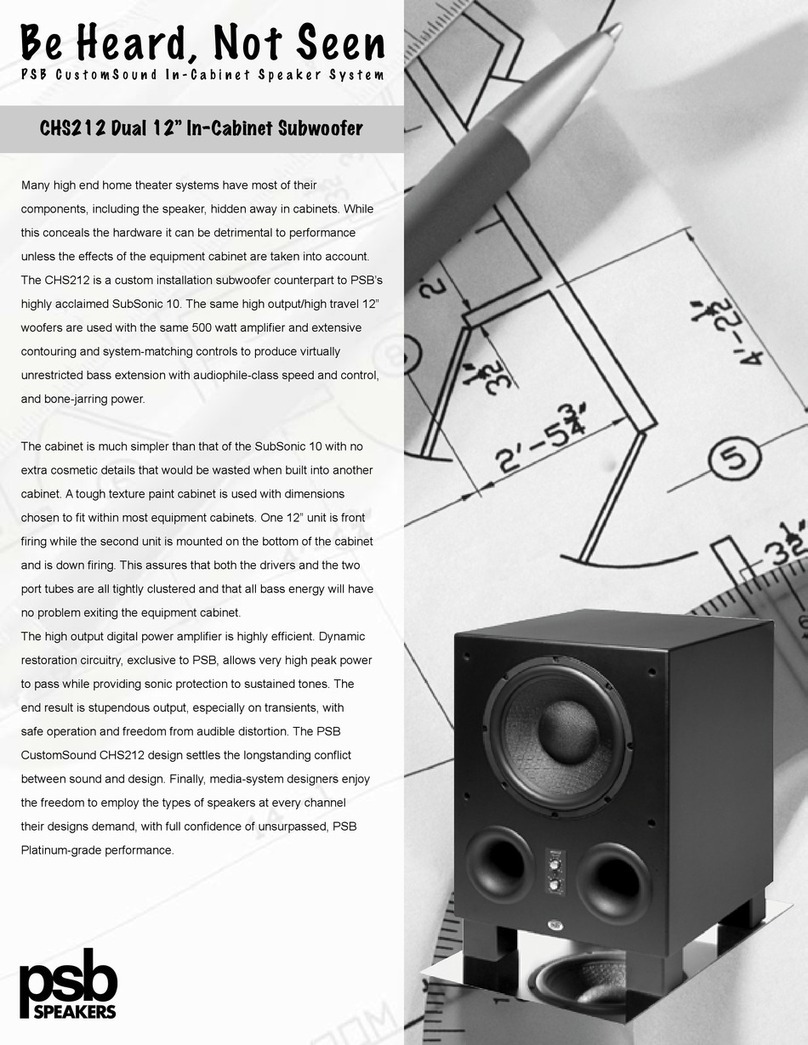
PSB
PSB CHS212 User manual
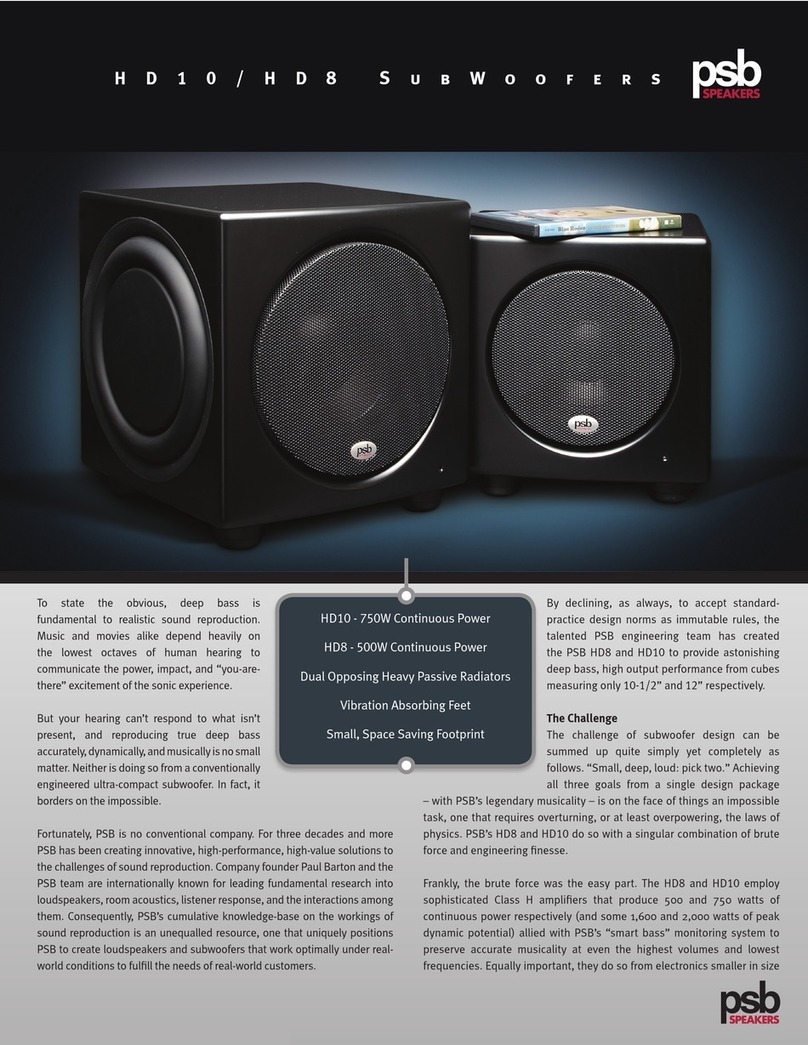
PSB
PSB HD10 User manual

PSB
PSB SubSeries 500 User manual

PSB
PSB Sub Series User manual
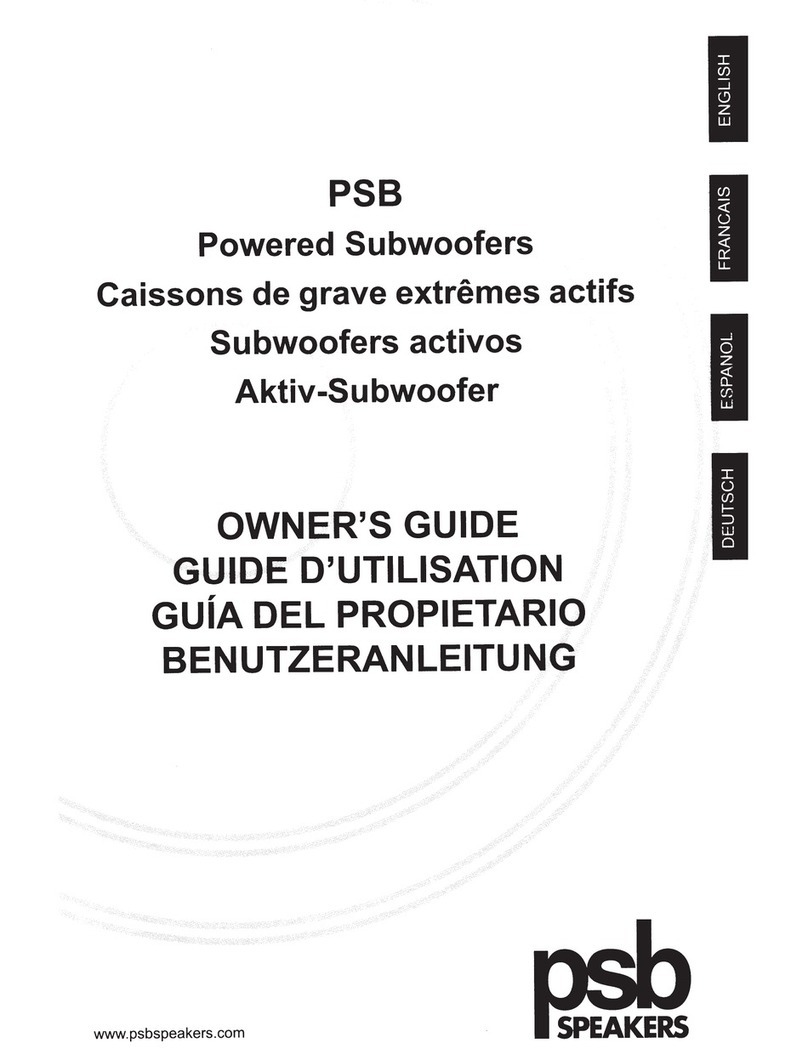
PSB
PSB Powered Subwoofers User manual

PSB
PSB SubSeries 500 User manual

PSB
PSB Powered Subwoofers User manual
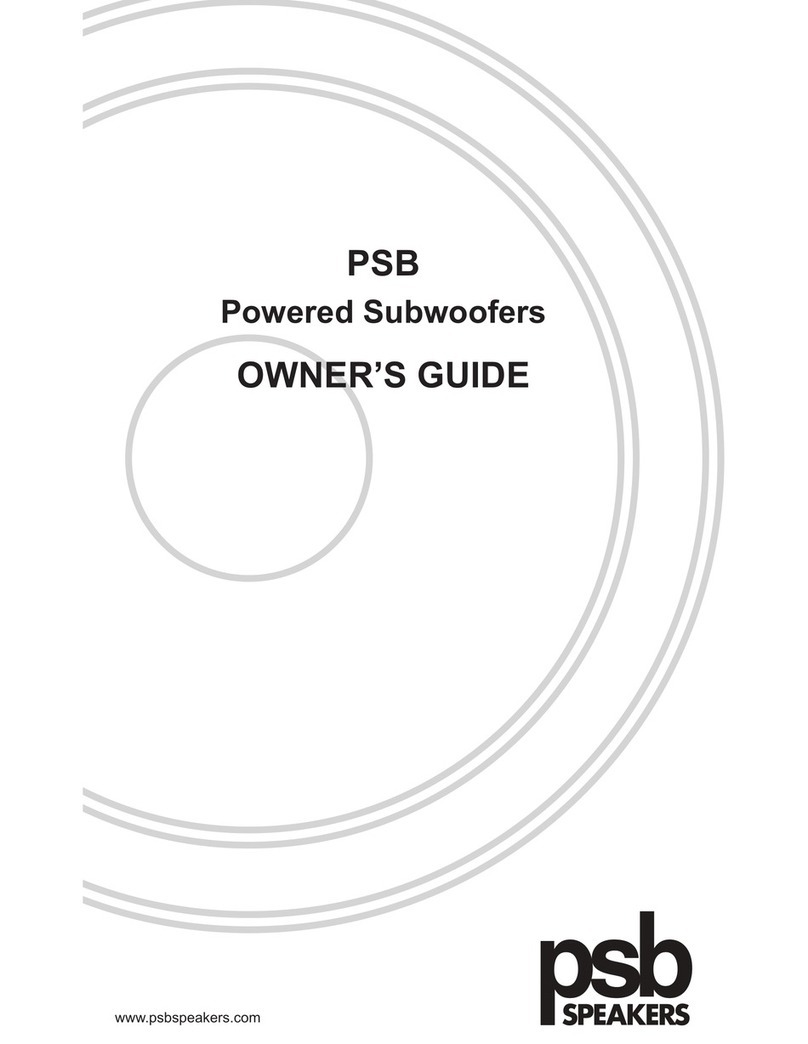
PSB
PSB SubSeries 450 User manual

PSB
PSB SubsSonic SubSonic5i User manual
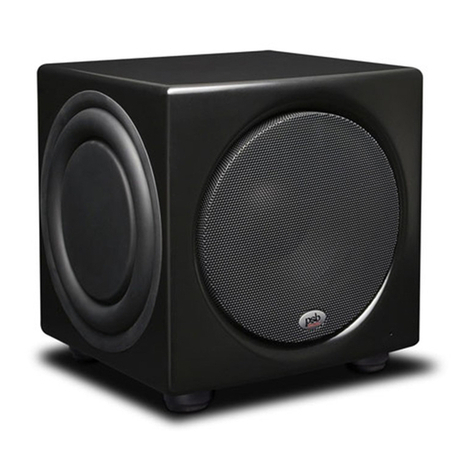
PSB
PSB HD8 User manual


